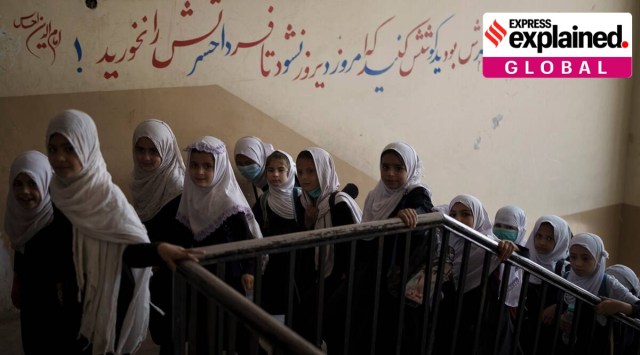Amid anti-Hijab protests, hundreds of schoolgirls in Iran ‘poisoned’: What is happening
Why have schoolgirls in Iran been allegedly poisoned, and how has the Iranian government responded? We explain.
 The reported attacks come at a time when Iran has faced months of protests after the death of Mahsa Amini. (Reuters/File)
The reported attacks come at a time when Iran has faced months of protests after the death of Mahsa Amini. (Reuters/File)
With Iran witnessing massive anti-hijab protests across the country over the last few months, hundreds of schoolgirls in the Islamic nation have been admitted to hospitals after suffering “mild poison” attacks, several reports said.
Iran’s deputy health Minister Younes Panahi told reporters on Sunday that “certain individuals sought the closure of all schools, especially girls’ schools,” state agency Fars reported. He added that “a large percentage” of the chemicals used to allegedly poison students are “treatable.”
Why have schoolgirls been allegedly poisoned, and how has the Iranian government responded? We explain.
Series of poisoning attacks in Iran since November
The alleged poisoning began in November 2022. According to the BBC, 700 girls have been poisoned since November. The cases were initially reported from Iran’s Qom city, with the first attack taking place on November 30, where 18 students from the Nour Technical School in Qom were taken to hospital.
Qom is about 160 km south of Tehran. It’s a deeply conservative and religious city that’s home to Iran’s clergy and theological seminaries where most of the country’s leaders and presidents have studied, Bloomberg has reported.
In the past week, at least 194 girls have been reportedly poisoned at four schools in the city of Borujerd. On Tuesday, another 37 students were poisoned at the Khayyam Girls’ School in Pardis, near the capital Tehran, BBC reported
Quoting local newspaper Etemad, Bloomberg has reported that at least 14 schools have been targeted across four cities, including the northwestern city of Ardebil, the capital of Tehran and the western city of Boroujerd.
Though no deaths have been reported, dozens of girls have suffered respiratory problems, nausea, dizziness and fatigue, and heart palpitations. Some described smelling tangerines, chlorine or cleaning agents before the onset of health effects.
Parents, and activists raise voice against attack
State news agencies and activists have on social media shared videos of parents protesting and confronting education officials and teachers, demanding a response to the incidents.
The minister of education of the Islamic regime in Iran admitted that the poisoning of the students was intentional.
The poisoning of school girls is the revenge of the terrorist regime of islamic Republic against the brave women who flagged the mandatory hijab & shook the… https://t.co/kwK3vtLHDs pic.twitter.com/ycddbT0ghA
— Masih Alinejad 🏳️ (@AlinejadMasih) February 26, 2023
On February 14, parents of students who had been admitted had gathered outside Qom’s governorate to “demand an explanation” from the authorities, IRNA reported.
Meanwhile, some have speculated that the poisonings have been done by those who “wished to copy” the Taliban in Afghanistan, or the militant Islamist group Boko Haram in Nigeria, by terrorising parents into stopping them from sending their girls to school.
In an Instagram post, Iranian politician Mohammad Ali Abtahi asked, “Has Boko Haram come to Iran?” He also warned that “extremists will interpret the boundaries of government and religion in their favour”.
Another prominent reformist politician, Azar Mansouri, linked the suspected poisoning attacks to hardline groups, referencing the Isfahan acid attacks.
“We said the acid attacks were organized. You said: You are disturbing public opinion! If operatives of the attacks were identified and punished then, today a group of reactionaries would not have ganged up on our innocent girls in the schools,” she tweeted.
گفتیم : #حملات_اسیدی به زنان اصفهان سازماندهی شده است.
گفتید: تشویش اذهان می کنید!
اگر همان موقع عاملان این حملات شناسایی و محاکمه می شدند، دوباره امروز عده ای واپس گرا و متحجر به جان دختران معصوم ما در مدارس نمی افتادند.
فبای ذنب قتلت
این #دختر_کشی را متوقف کنید.— Azar Mansoori (@MansooriAzar) February 26, 2023
The Guardian spoke to Masih Alinejad, an Iranian human rights activist based in New York, who said, “In my opinion, this chemical attack is revenge by the Islamic Republic against the brave women who [rejected] the mandatory hijab and shook the ‘Berlin Wall’ of [Ayatollah Ali] Khamenei”.
Parents have already started to pull their children from classes, according to a report by Shargh, a reformist news website based in Tehran. What several fear is that girls could be poisoned apparently just for seeking an education, something that hasn’t been challenged since the 1979 Islamic Revolution.
What is the response of the Iranian government?
Initially, authorities did not link the cases. The Associated Press reported that due to winters in Iran, many schools are usually heated by natural gas, which led to the speculation that carbon monoxide poisoning was affecting the girls. The country’s education minister had then dismissed the reports as “rumours”.
Soon after, it surfaced that the schools affected at first had only taught women, fuelling suspicion it wasn’t accidental. Iran’s prosecutor-general ordered an investigation, saying “there are possibilities of deliberate criminal acts.” Iran’s Intelligence Ministry reportedly investigated as well, AP reported.
It was officially confirmed after Iran’s deputy health minister, Younes Panahi, said some people had been poisoned at a girls’ school in Qom with the aim of shutting down education for girls. “After the poisoning of several students in Qom schools, it was found that some people wanted all schools, especially girls’ schools, to be closed,” state agency IRNA quoted him as saying at the time.
Panahi added: “It has been revealed that the chemical compounds used to poison students are not war chemicals … the poisoned students do not need aggressive treatment and a large percentage of the chemical agents used are treatable.”
On Tuesday, Iran’s parliament held a meeting to discuss the suspected attacks in the presence of Health Minister Bahram Eynollahi, the official IRNA news agency reported. IRNA also quoted the parliament’s speaker, Mohammad Bagher Ghalibaf, as saying that both Qom and Borujerd were “dealing with student poisonings”.
Ali Reza Monadi, a national parliament member, described the poisonings as “intentional.” The ”existence of the devil’s will to prevent girls from education is a serious danger and it is considered very bad news,” he said, Bloomberg reported. “We have to try to find roots” of this.
The authorities have not yet named any suspects.
Anti-Hijab protests and past attacks in Iran
Since September last year, Iran has witnessed anti-government protests sparked by the death of 22-year-old Mahsa Amini in police custody. Amini was visiting Tehran from the Kurdish city of Saqez when she was detained for not wearing her veil properly. After her death, women poured out on the streets protesting against the government, with many burning their hijabs.
Before that, in 2014, there had been a series of acid attacks on women in Iran’s Isfahan because the victims were wearing clothing or headscarves that did not conform to perceived Islamic norms, though authorities have so far denied that the assaults had anything to do with the hijab.
— With agency inputs
Photos



- 01
- 02
- 03
- 04
- 05



































